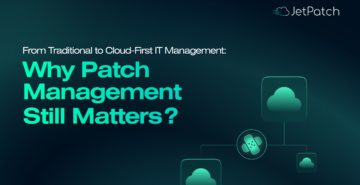Predictive patching is a crucial aspect of maintaining a secure and efficient IT environment. In today’s world, where cyber threats are on the rise, it is important to be proactive in dealing with these threats. One such tool that is making waves in the industry is JetPatch’s predictive patching feature. its is a mechanism that runs in the background of your IT environment and constantly looks for technical reasons why your patch cycle may not be successful.
In this video, we get a glimpse of how predictive patching works in JetPatch.
The video walks us through the steps of using predictive patching in JetPatch. We start by going to the patches section, where we can see the default settings for predictive. We can perform predictive patching based on our operating systems and groups. If we don’t filter anything, predictive patching will run on the entire environment.
When we run the plan on our entire environment, we see that we are close to 100% but not perfect. If we click on “how to improve,” we will see a list of exemptions that may be preventing our patching cycle from being 100% successful.
If we don’t care about our entire environment right now, we can simply group B. When we run predictive patching on group B, we can see that we are 100% ready to start patching with group B.
Benefits of Predictive Patching
it is a proactive approach to patch management that enables organizations to stay ahead of potential security threats and minimize downtime. It leverages advanced analytics and machine learning to identify and prioritize patches that are most critical to an organization’s IT environment. Doing so, it allows IT teams to focus their efforts on the most important patches, reducing the risk of cyberattacks and improving the overall security posture of the organization.
Here are some of the key benefits of using a Predictive Patching solution:
- Proactive approach: it’s enables organizations to be proactive rather than reactive when it comes to patch management. By identifying and prioritizing critical patches before they become a problem, IT teams can ensure that they are always ahead of potential security threats.
- Improved security: One of the primary benefits is improved security. By identifying and prioritizing critical patches, organizations can minimize the risk of cyberattacks and data breaches. it’s enables IT teams to focus their efforts on the patches that matter most, ensuring that critical vulnerabilities are patched in a timely manner.
- Reduced downtime: Downtime can be costly for organizations. Predictive can help minimize downtime by identifying and patching critical vulnerabilities before they cause system failures or outages. This reduces the need for emergency patching and ensures that systems remain up and running.
- Cost-effective: Predictive can help organizations save money by reducing the need for emergency patching, minimizing downtime, and improving overall system security. It also reduces the workload of IT teams, allowing them to focus on other critical tasks.
- Automation: Predictive solutions often include automation features that help streamline the patch management process. This reduces the workload on IT teams and enables them to patch systems more quickly and efficiently.
It can be used in a variety of ways. We can use it broadly on our entire environment or narrow it down to the applicable endpoints by filtering the operating system and/or endpoint group. Alternatively, if we have a remediation plan ready to go, we can run the simulation directly on the remediation plan to check all the endpoints within the plan.
Conclusion
In conclusion, predictive patching is an important tool that helps maintain a secure and efficient IT environment. JetPatch’s predictive patching feature makes it easy to identify technical reasons why your patch cycle may not be successful and provides suggestions for improvement. By using predictive patching, we can be proactive in dealing with cyber threats and ensure that our IT environment remains secure.



